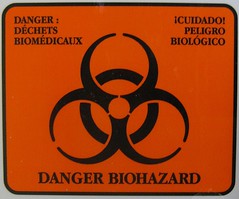FORECAST SUMMARY
Movie set in: 2027
Event / Likelihood
Universal sterility — low
Global flu pandemic — high
RATINGS
Overall rating: 6.8 (9th of 124 movies)
Futurism rating: 6
The movie is thoughtful but devotes most of its energy to the issues of today rather than the ramifications of its central premise.
Entertainment rating: 8
Tense and uncompromising, and serious about everything it depicts, Children of Men is a well-made movie.
Plausibility rating: 7
There are ways something like this could occur, and the effects might be much like those shown.
Approach to the future
Backdrop for storytelling that takes it cues from our own time.
TOPICS DEPICTED
Universal sterility
No children have been born since 2009, and an 18-year-old Argentine holds the title of “world’s youngest person.”
The cause is unknown–biotechnology is mentioned as a possibility–but the effects have been dire: without new generations to give life meaning, most societies have collapsed, and only Britain seems to have remained intact.
Such an event is unlikely but possible, and the possibility is rising as the reach of technologies grows. The three most likely routes are chemicals, biotechology, and nanotechnology.
We use thousands of chemicals, and introduce more every day, and the precise effects of each one of them are unknown. Some are suspected of being dangerous to health, including reproductive health, and have spread to every corner of the planet. In the developed world, the remains of pharmaceuticals are now extremely widespread in drinking water.
Biotechnology is spreading, with only partial regulation, and most humans now consume genetically engineered food products. While it seems unlikely that they would have drastic effects, the potential for accidents will grow if pharming–using agriculture to produce drugs–becomes widespread.
A newly emerging threat is nanotechnology. Nanotechnological materials are being produced on a mass scale and used in many consumer products, with very little understanding of their interaction with human health or the environment.
Some suggest that we should heed the fate of frogs: the are in decline around the planet, and we don’t know why. If we’ve done something to them, we might be doing it to ourselves as well.
Flu pandemic
A flu pandemic strikes in 2008, though its scale is not clear.
This is nearly inevitable.
A pandemic flu, such as avian flu, could strike at any time. Effects could be relatively mild, but some forecast death tolls of 80 million or even higher.
Such a calamity would shake the global system and could destabilize some fragilie societies.
 Popular Mechanics evaluated the science of The Crazies yesterday.
Popular Mechanics evaluated the science of The Crazies yesterday. Chanda Phelan has a great piece on
Chanda Phelan has a great piece on  A journalist recently asked me to comment as a futurist on the supposed disaster that some foresee for 2012.
A journalist recently asked me to comment as a futurist on the supposed disaster that some foresee for 2012.